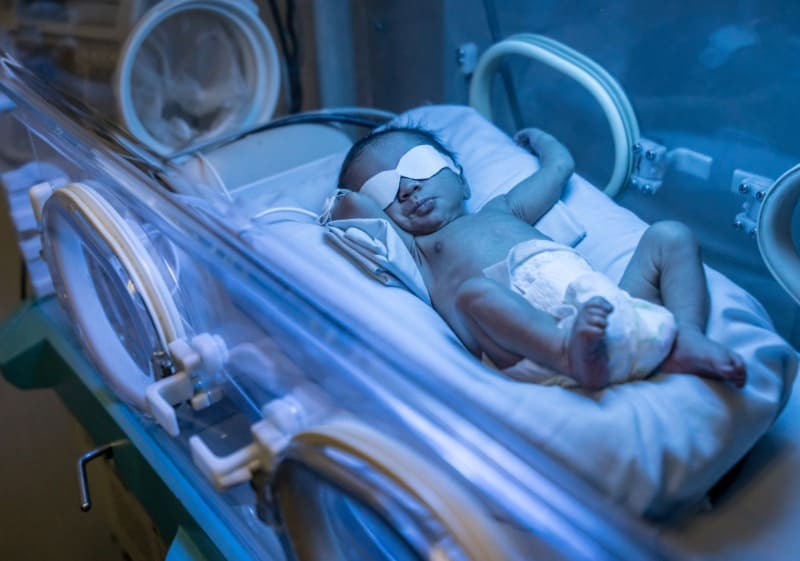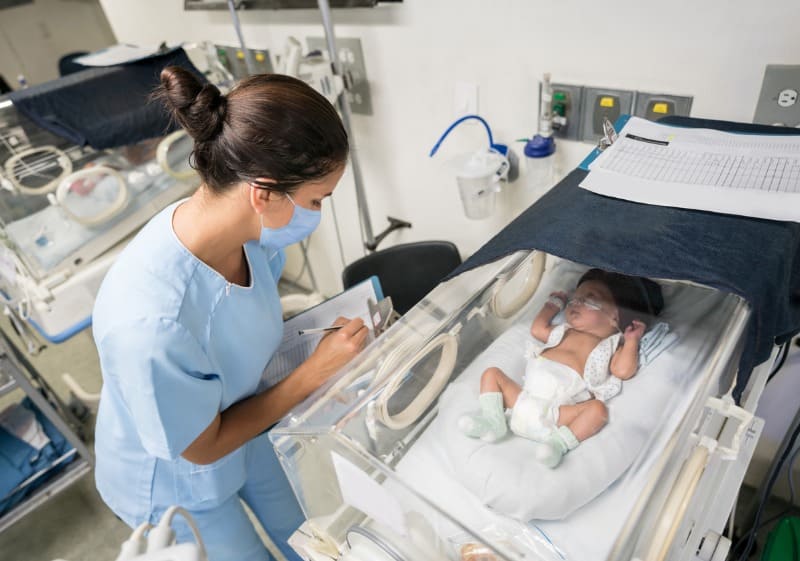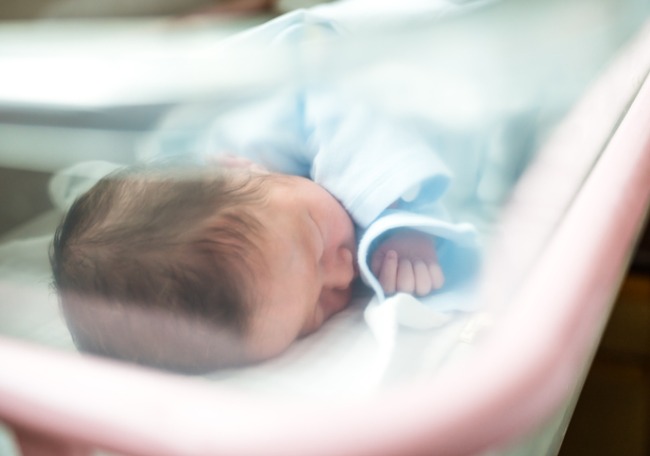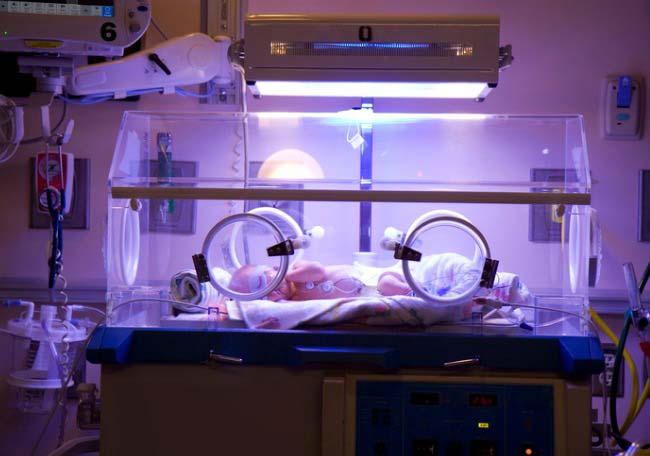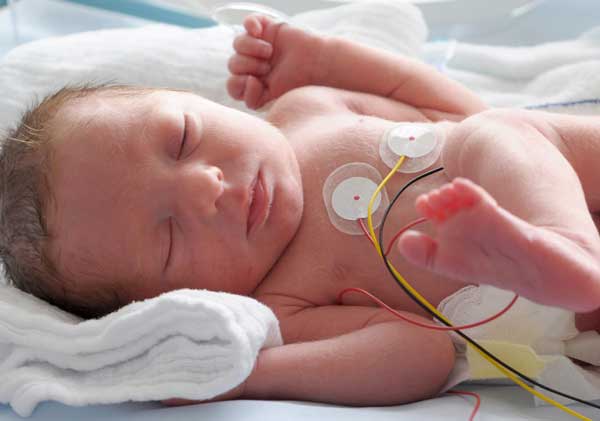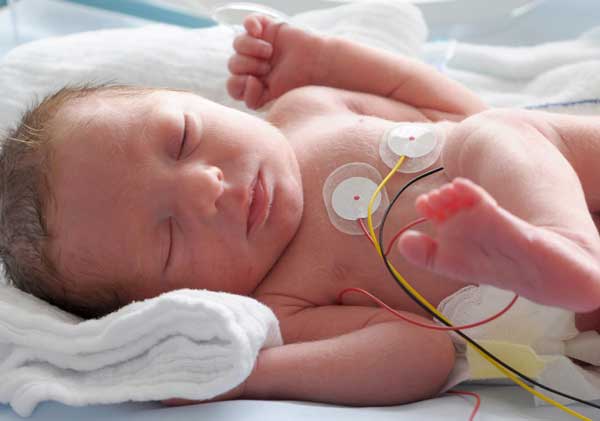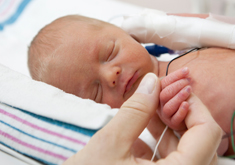Hiperbilirrubinemia neonatal
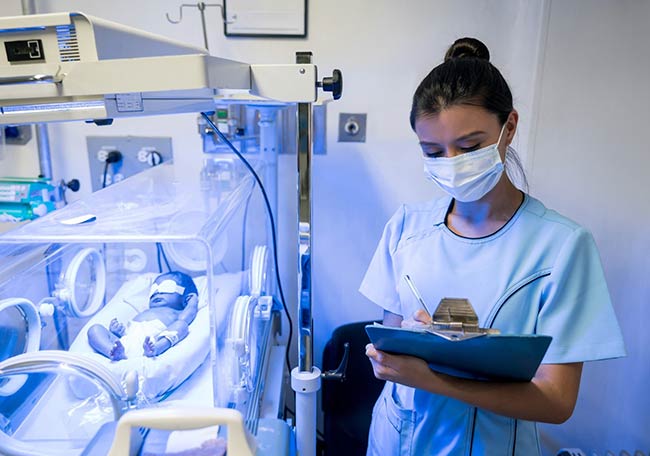
1 Holt LE. The diseases of infancy and childhood: for the use of students and practitioners of medicine. New York: D. Appleton, 1897.
2 Dennery PA, Seidman DS, Stevenson DK. Neonatal hyperbilirubinemia. N Engl J Med 2001; 344: 581–90.
3 Kaplan M, Muraca M, Hammerman C, et al. Imbalance between production and conjugation of bilirubin: a fundamental concept in the mechanism of neonatal jaundice. Pediatrics 2002; 110: e47.
4 Hansen TWR. Pathophysiology of kernicterus. In: Polin RA, Abman SH, Rowitch DH, Benitz WE, Fox WW, eds. Fetal and neonatal physiology, 5th edn. Philadelphia: Elsevier, 2016: 1657–67.
5 Le Pichon JB, Riordan SM, Watchko J, Shapiro SM. The neurological sequelae of neonatal hyperbilirubinemia: definitions, diagnosis and treatment of the kernicterus spectrum disorders (KSDs). Curr Pediatr Rev 2017; 13: 199–209.
6 Watchko JF, Tiribelli C. Bilirubin-induced neurologic damage—mechanism and management approaches. N Engl J Med 2013; 369: 2021–30.
7 Dore S, Takahashi M, Ferris CD, et al. Bilirubin, formed by activation of heme oxygenase-2, protects neurons against oxidative stress injury. Proc Natl Acad Sci USA 1999; 96: 2445–50.
8 Farrera JA, Jauma A, Ribo JM, et al. The antioxidant role of bile pigments evaluated by chemical tests. Bioorg Med Chem 1994; 2: 181–85.
9 Lane E, Murray KF. Neonatal cholestasis. Pediatr Clin North Am 2017; 64: 621–39.
10 UN. Sustainable Development Goals. 2015.
http://www.un.org/ sustainabledevelopment/sustainable-development-goals/ (accessed March 25, 2018).
11 Lawn JE, Blencowe H, Oza S, et al. Every Newborn: progress, priorities, and potential beyond survival. Lancet 2014; 384: 189–205.
12 Olusanya BO, Teeple S, Kassebaum NJ. The contribution of neonatal jaundice to global child mortality: findings from the GBD 2016 study. Pediatrics 2018; 141: e20171471.
13 Riskin A, Abend-Weinger M, Bader D. How accurate are neonatologists in identifying clinical jaundice in newborns? Clin Pediatr (Phila) 2003; 42: 153–58.
14 National Institute for Health and Care Excellence. Neonatal jaundice: clinical guideline 98. May, 2010. https://www.nice.org.uk/guidance/cg98 (accessed March 25, 2018).
15 Bhutani VK, Stark AR, Lazzeroni LC, et al. Predischarge screening for severe neonatal hyperbilirubinemia identifies infants who need phototherapy. J Pediatr 2013; 162: 477–82.
16 UNICEF. The state of the world’s children 2017. Children in a digital world. December, 2017. https://www.unicef.org/publications/index_101992.html (accessed March 25, 2018).
17 Ip S, Chung M, Kulig J, et al. An evidence-based review of important issues concerning neonatal hyperbilirubinemia. Pediatrics 2004; 114: e130–53.
18 Bhutani VK, Vilms RJ, Hamerman-Johnson L. Universal bilirubin screening for severe neonatal hyperbilirubinemia. J Perinatol 2010; 30 (suppl): S6–15.
19 Olusanya BO, Ogunlesi TA, Kumar P, et al. Management of late-preterm and term infants with hyperbilirubinaemia in resource-constrained settings. BMC Pediatr 2015; 15: 39.
20 Slusher TM, Zamora TG, Appiah D, et al. Burden of severe neonatal jaundice: a systematic review and meta-analysis. BMJ Paediatr Open 2017; 1: e000105.
21 The Young Infants Clinical Signs Study Group. Clinical signs that predict severe illness in children under age 2 months: a multicentre study. Lancet 2008; 371: 135–42.
22 Lain SJ, Roberts CL, Bowen JR, Nassar N. Early discharge of infants and risk of readmission for jaundice. Pediatrics 2015; 135: 314–21.
23 Battersby C, Michaelides S, Upton M, et al. Term admissions to neonatal units in England: a role for transitional care? A retrospective cohort study. BMJ Open 2017; 7: e016050.
24 McGillivray A, Evans N. Severe neonatal jaundice: is it a rare event in Australia? J Paediatr Child Health 2012; 48: 801–07.
25 Mreihil K, Benth JŠ, Stensvold HJ, Nakstad B, Hansen TWR. Phototherapy is commonly used for neonatal jaundice, but greater control is needed to avoid toxicity in the most vulnerable infants. Acta Paediatr 2018; 107: 611–19.
26 Young TK. Population health: concepts and methods 2nd edn. New York: Oxford University Press, 2005.
27 Agyepong I, Corrah T, Guo Y, et al. Making sense of health estimates. Lancet 2015; 385: 1377–79.
28 Bhutani VK, Zipursky A, Blencowe H, et al. Neonatal hyperbilirubinemia and rhesus disease of the newborn: incidence and impairment estimates for 2010 at regional and global levels. Pediatr Res 2013; 74 (suppl 1): 86–100.
29 GBD 2016 Causes of Death Collaborators. Global, regional, and national age-sex specific mortality for 264 causes of death, 1980–2016: a systematic analysis for the Global Burden of Disease Study 2016. Lancet 2017; 390: 1151–210.
30 Mwaniki MK, Atieno M, Lawn JE, Newton CRJC. Long-term neurodevelopmental outcomes after intrauterine and neonatal insults: a systematic review. Lancet 2012; 379: 445–52.
31 Olusanya BO, Ogunlesi TA, Slusher TM. Why is kernicterus still a major cause of death and disability in low-income and middle-income countries? Arch Dis Child 2014; 99: 1117–21.
32 GBD 2016 DALYs and HALE Collaborators. Global, regional, and national disability-adjusted life-years (DALYs) for 333 diseases and injuries and healthy life expectancy (HALE) for 195 countries and territories, 1990–2016: a systematic analysis for the Global Burden of Disease Study 2016. Lancet 2017; 390: 1260–344.
33 American Academy of Pediatrics Subcommittee on Hyperbilirubinemia. Management of hyperbilirubinaemia in the newborn infant 35 or more weeks of gestation. Pediatrics 2004; 114: 297–316.
34 Olusanya BO, Osibanjo FB, Slusher TM. Risk factors for severe neonatal hyperbilirubinemia in low and middle-income countries: a systematic review and meta-analysis. PLoS One 2015; 10: e0117229.
35 Raju TN. Developmental physiology of late and moderate prematurity. Semin Fetal Neonatal Med 2012; 17: 126–31.
36 Watchko JF. Bilirubin-induced neurotoxicity in the preterm neonate. Clin Perinatol 2016; 43: 297–311.
37 Amin SB, Wang H, Laroia N, Orlando M. Unbound bilirubin and auditory neuropathy spectrum disorder in late preterm and term infants with severe jaundice. J Pediatr 2016; 173: 84–89.
38 Johnson L, Bhutani VK, Karp K, et al. Clinical report from the pilot USA kernicterus registry (1992 to 2004). J Perinatol 2009; 29 (suppl 1): S25–45.
39 Kaplan M, Hammerman C. Hemolytic disorders and their management. In: Stevenson DK, Maisels MJ, Watchko JF, eds. Care of the jaundiced neonate. New York: McGraw-Hill, 2012: 145–73.
40 Gamaleldin R, Iskander I, Seoud I, et al. Risk factors for neurotoxicity in newborns with severe neonatal hyperbilirubinemia. Pediatrics 2011; 128: e925–31.
41 Nkhoma ET, Poole C, Vannappagari V, Hall SA, Beutler E. The global prevalence of glucose-6-phosphate dehydrogenase deficiency: a systematic review and meta-analysis. Blood Cells Mol Dis 2009; 42: 267–78.
42 Griffiths PD, Huntsman RG, Thomas CG. Neonatal jaundice from sepsis. BMJ 1964; 1: 7–8.
43 WHO. Guideline: protecting, promoting and supporting breastfeeding in facilities providing maternity and newborn services. 2017.
http://www.who.int/nutrition/publications/guidelines/breastfeeding-facilities-maternity-newborn/en/ (accessed March 25, 2018).
44 Academy of Breastfeeding Medicine Protocol Committee. ABM clinical protocol #22: guidelines for management of jaundice in the breastfeeding infant equal to or greater than 35 weeks’ gestation. Breastfeed Med 2010; 5: 87–93.
45 Committee on Obstetric Practice. Committee opinion no. 684: delayed umbilical cord clamping after birth. Obstet Gynecol 2017; 129: e5–e10.
46 McDonald SJ, Middleton P, Dowswell T, Morris PS. Effect of timing of umbilical cord clamping of term infants on maternal and neonatal outcomes. Evid Based Child Health 2014; 9: 303–97.
47 Frank R, Garfinkle J, Oskoui M, Shevell MI. Clinical profile of children with cerebral palsy born term compared with late- and post-term: a retrospective cohort study. BJOG 2017; 124: 1738–45.
48 Monbaliu E, Himmelmann K, Lin JP, et al. Clinical presentation and management of dyskinetic cerebral palsy. Lancet Neurol 2017; 16: 741–49.
49 Wu YW, Kuzniewicz MW, Wickremasinghe AC, et al. Risk for cerebral palsy in infants with total serum bilirubin levels at or above the exchange transfusion threshold: a population-based study. JAMA Pediatr 2015; 169: 239–46.
50 Shapiro SM, Popelka GR. Auditory impairment in infants at risk for bilirubin-induced neurologic dysfunction. Semin Perinatol 2011; 35: 162–70.
51 Wickremasinghe AC, Risley RJ, Kuzniewicz MW, et al. Risk of sensorineural hearing loss and bilirubin exchange transfusion thresholds. Pediatrics 2015; 136: 505–12.
52 Akinpelu OV, Waissbluth S, Daniel SJ. Auditory risk of hyperbilirubinemia in term newborns: a systematic review. Int J Pediatr Otorhinolaryngol 2013; 77: 898–905.
53 Amin SB, Saluja S, Saili A, et al. Chronic auditory toxicity in late preterm and term infants with significant hyperbilirubinemia. Pediatrics 2017; 140: e20164009.
54 Hua J, Gu G, Jiang P, Zhang L, Zhu L, Meng W. The prenatal, perinatal and neonatal risk factors for children’s developmental coordination disorder: a population study in mainland China. Res Dev Disabil 2014; 35: 619–25.
55 Maimburg RD, Olsen J, Sun Y. Neonatal hyperbilirubinemia and the risk of febrile seizures and childhood epilepsy. Epilepsy Res 2016; 124: 67–72.
56 Maimburg RD, Bech BH, Vaeth M, Moller-Madsen B, Olsen J. Neonatal jaundice, autism, and other disorders of psychological development. Pediatrics 2010; 126: 872–78.
57 Amin SB, Smith T, Wang H. Is neonatal jaundice associated with autism spectrum disorders: a systematic review. J Autism Dev Disord 2011; 41: 1455–63.
58 Lozada LE, Nylund CM, Gorman GH, Hisle-Gorman E, Erdie-Lalena CR, Kuehn D. Association of autism spectrum disorders with neonatal hyperbilirubinemia. Glob Pediatr Health 2015; 2: 2333794X15596518.
Comentarios
Para ver los comentarios de sus colegas o para expresar su opinión debe ingresar con su cuenta de IntraMed.
